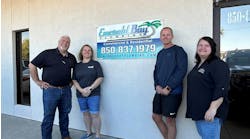Special to CONTRACTOR
LANCASTER, PA. — Hot water recirculation for domestic water systems has created a lot of buzz these days, spurred primarily by consumer demand for hot water instantly at the tap.
Recirculating hot water bumps into two trends. On the one hand, houses are getting bigger, featuring master baths with giant tubs located farther from the hot water source. On the other hand, it’s wasteful to let all that water go down the drain, even if it is the drain of a shower with six heads.
Statistics promoted by the manufacturers of hot water recirculation systems show that the technology saves 11,000 to 15,000 gal. of water each year for a family of four. In larger homes, with more faucets and showers and longer water lines between the water heater and distant bathrooms, the amount of water that’s wasted can be higher.
CONTRACTOR plumbing columnist Dave Yates, who owns contracting firm F.W. Behler Inc. in York, Pa., said he believes that water savings could be from 3,000 gal. to 12,000 gal. in most types of houses. F.W. Behler recently retrofit a recirculation system as well as hydronic heating and air conditioning equipment in a 3,250-sq.-ft., five-year-old house here.
Yates said that his arithmetic shows that 100 ft. of 12-in. line would hold about 1 gal. of water. If the hot water recirculation system has to heat up the tubing, that’s 2 gal. of water down the drain. So, he said that he figures the savings for this particular house would be 6,000 gal.
A recirculation system saves money in other ways. This house uses well water that takes electricity to pump and a UV light and treatment chemicals to purify. The waste goes into a septic system that might have to be pumped more often if it gets overloaded.
“But it’s still more of a comfort and convenience, rather than cost,” Yates told CONTRACTOR.
Comfort and convenience were the goals of the homeowner, who asked not to be named, when he spent $650 for a wall-hung instantaneous water heater that he saw two years ago at a home show. The problem he hoped to solve was lengthy waits for hot water at the more remote faucets and showerheads. In the winter that amounted to a 90-second wait for warm water.
F.W. Behler Inc. had installed a direct-vent, propane-fired Peerless hot water boiler and a 50-gal. Peerless storage tank that can produce about 220 gal. per hour. Capacity was definitely not the problem; distance was. Specifically, the real problem was the 70-ft. run of uninsulated 12-in. tubing from the domestic hot water tank to the master bathroom, Yates said.
The homeowner insisted that the wall-hung water heater would solve the problem, even after Behler hydronic technician Bob Sieger explained that the unit wasn’t intended for use as a source of instant hot water at the tap, but rather as a reliable source of hot water, produced quickly. After the unit was installed, the waiting time for hot water was still 30 seconds.
“The homeowner asked about that and we reminded him that the wall-hung unit, though very reliable and responsive, was still some distance from the nearest master bath fixture, and it took time to evacuate that line,” Sieger said.
Shortly after that conversation, Sieger spotted a flyer for technology that would, as a retrofit, recirculate domestic hot water without the need for a dedicated return line. Yates noted that most pump manufacturers produce similar types of recirculating devices.
“The unit we chose was a ready-for-retrofit, pump and valve combo sold by Grundfos,” Sieger said.
A plumbing contractor can install the Comfort System from Grundfos within an hour or two. The unit begins working when the timer-activated pump at the hot water tank pushes hot water toward a valve beneath the furthest fixture in the house. The valve connects the hot and cold water supply lines.
As long as the water in the hot line is less than 98° F, the valve stays open and the cold water is sent back to the heater through the cold water line. Hot water stands ready to come out when the tap is turned on. When the hot side of the tap reaches 98° F, the valve closes, stopping circulation, and reopens when the temperature dips below the device-activated 98° F setpoint.
The system operates because the pump creates a small pressure differential between the hot- and cold-water sides, said Tom Phillips, Grundfos business specialist. A thin wax filament inside the valve enclosure expands and contracts predictably, contracting when it’s cold to open the valve and closing as the wax expands with the heat from the water.
The only downside to the technology is that, though huge amounts of water are saved, minimally more energy is used for water heating. That’s because the water is cycled through the lines continuously, even when not in use.
The best way to overcome that is to insulate the hot water lines and put a timer on the pump so it only runs during peak times, not in the middle of the night or when everyone is at work or school.

